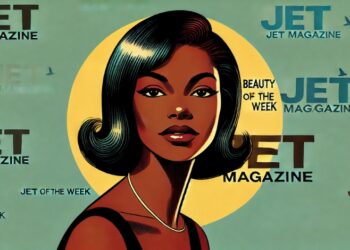Explore the iconic Jet magazine covers that shaped Black culture, showcasing history, triumphs, and timeless representations of excellence.
Jet Magazine, a publication that started in 1951, has long been a cornerstone of Black media. For decades, its covers were more than just glossy images; they were powerful cultural artifacts. These covers chronicled the struggles, triumphs, and evolving aesthetics of Black America, making Jet a household name and an enduring symbol of Black excellence. Let’s dive into the rich tapestry of Jet magazine covers, exploring their history, cultural significance, and why they remain iconic today.
What You'll Discover:
A Brief History of Jet Magazine
Founded by John H. Johnson, Jet Magazine was conceived as a newsweekly for African Americans. Its mission was straightforward but profound: to tell stories that mainstream media overlooked. The magazine’s compact size made it a staple on coffee tables, in barbershops, and even in pockets. But it was the covers that truly set Jet apart.
From the outset, Jet covers featured prominent figures in the Black community—musicians, activists, athletes, and actors—often accompanied by bold headlines that captured the zeitgeist. Each issue offered a window into the heart of Black America, showcasing beauty, resilience, and unyielding progress.
The Power of Representation
Imagine growing up in the 1960s or 70s and rarely seeing people who looked like you on television or in mainstream publications. Jet Magazine covers filled that void, celebrating Black beauty, talent, and achievements. For many, flipping through Jet felt like a validation—a reminder that they were seen, valued, and celebrated.
Take the cover featuring Dorothy Dandridge in the 1950s. As the first Black woman nominated for an Academy Award for Best Actress, her appearance on Jet’s cover wasn’t just about entertainment; it was a declaration of possibility. Similarly, covers featuring Muhammad Ali in the 1960s showcased not just his prowess in the ring but his unapologetic pride in his Black identity.
The “Beauty of the Week” Phenomenon
One of Jet’s most famous features was the “Beauty of the Week.” While some criticized it for objectifying women, others saw it as a groundbreaking celebration of Black beauty. These weekly spreads presented women of varying skin tones, hair textures, and body types—a diversity rarely seen in media at the time. For many Black women, it was the first time they saw their own beauty reflected back at them in such a public way.
Let’s not forget the cultural ripple effects. The “Beauty of the Week” inspired countless young women to embrace their natural beauty long before movements like #BlackGirlMagic gained traction. These images were more than just eye candy; they were affirmations.
Chronicling the Civil Rights Movement
Jet Magazine wasn’t just about entertainment and lifestyle; it was deeply political. During the Civil Rights Movement, its covers became rallying cries. The 1955 cover featuring Emmett Till’s open-casket funeral remains one of the most harrowing and impactful images in American history. It brought the brutal reality of racism into stark focus, galvanizing a generation to fight for justice.
Similarly, covers featuring leaders like Dr. Martin Luther King Jr., Malcolm X, and Rosa Parks provided visibility to the movement. These weren’t just photos; they were acts of defiance against a media landscape that often ignored Black voices.
Icons Who Graced the Covers
Jet covers read like a who’s who of Black excellence. From Aretha Franklin to Serena Williams, the magazine celebrated figures who broke barriers and set new standards.
- Music Legends: Covers featuring James Brown, Whitney Houston, and Prince captured the evolving soundscapes of Black music.
- Hollywood Stars: Diahann Carroll, Sidney Poitier, and Halle Berry graced covers that celebrated their groundbreaking achievements in film and television.
- Athletes: From Jackie Robinson to LeBron James, Jet chronicled the rise of Black athletes who redefined their sports.
Each cover was more than just a picture; it was a story, a milestone, a piece of history.
The Visual Aesthetic
Jet Magazine covers were instantly recognizable. Their bold, bright colors and sharp typography made them pop off the newsstands. The photography was often striking, capturing subjects in moments of confidence and vulnerability. Over time, the aesthetic evolved, reflecting shifts in fashion, technology, and design trends.
For instance, compare a Jet cover from the 1960s with one from the 1990s. The earlier covers often featured simple, direct portraits against plain backgrounds, while later issues embraced more dynamic compositions and editorial styles. This evolution mirrored the growing complexity and sophistication of Black cultural expression.
Cultural Impact
Jet Magazine covers didn’t just reflect culture; they shaped it. They set trends, sparked conversations, and challenged norms. When Jet featured natural hairstyles on its covers, it helped normalize them in a world that often stigmatized Black hair. When it highlighted interracial relationships, it pushed boundaries and invited dialogue.
Even today, these covers remain a treasure trove for historians, artists, and anyone interested in the Black experience. They’re cited in academic papers, featured in exhibitions, and shared across social media platforms. Each cover is a time capsule, capturing the mood, aspirations, and challenges of its era.
Why Jet Magazine Covers Still Matter
In an age of digital media, where images are fleeting and often disposable, Jet Magazine covers endure. They remind us of the power of print and the importance of representation. They’re a testament to the resilience and creativity of Black communities.
Moreover, they offer lessons for today’s media creators. Jet showed that authenticity and cultural specificity aren’t limiting; they’re empowering. In celebrating the unique experiences of Black Americans, it created something universally resonant.
Preserving the Legacy
As Jet transitioned from print to digital, its covers—both old and new—continue to be celebrated. Efforts to digitize and archive these covers ensure that future generations can access this rich history.
Collectors also play a crucial role in preserving Jet’s legacy. Vintage issues are highly sought after, often treated as sacred artifacts. Whether displayed in homes or studied in libraries, these covers remain powerful symbols of Black pride and achievement.
Key Takings
- Jet Magazine covers weren’t just about the past or present—they imagined a future where Black excellence was the norm.
- They provide a blueprint for addressing identity, representation, and equity in media.
- Media isn’t just a mirror; it’s a canvas to challenge stereotypes, elevate voices, and inspire change.
- Every piece of media, from magazine covers to social posts, tells a story—ask what story it’s telling and who it’s for.
- Jet Magazine set a high standard for representation; it’s up to us to continue that legacy.





